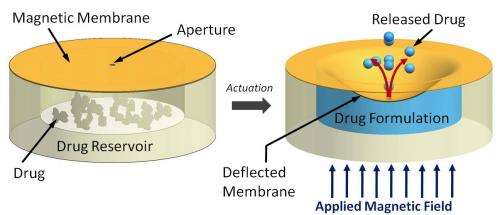Researchers invent new drug delivery device to treat diabetes-related vision loss

A team of engineers and scientists at the University of British Columbia has developed a device that can be implanted behind the eye for controlled and on-demand release of drugs to treat retinal damage caused by diabetes.
Diabetic retinopathy is the leading cause of vision loss among patients with diabetes. The disease is caused by the unwanted growth of capillary cells in the retina, which in its advanced stages can result in blindness.
The novel drug delivery mechanism is detailed in the current issue of Lab on a Chip, a multidisciplinary journal on innovative microfluidic and nanofluidic technologies.
The lead authors are recent PhD mechanical engineering graduate Fatemeh Nazly Pirmoradi, who completed the study for her doctoral thesis, and Mechanical Engineering Assoc. Prof. Mu Chiao, who studies nanoscience and microelectromechanical systems for biological applications.
The co-authors are Prof. Helen Burt and research scientist John Jackson at the Faculty of Pharmaceutical Sciences.
“We wanted to come up with a safe and effective way to help diabetic patients safeguard their sight,” says Chiao who has a family member dealing with diabetic retinopathy.
A current treatment for diabetic retinopathy is laser therapy, which has side effects, among them laser burns or the loss of peripheral or night vision. Anti-cancer drugs may also used to treat the disease. However, these compounds clear quickly from the bloodstream so high dosages are required, thus exposing other tissues to toxicity.
Key to UBC’s innovation is the ability to trigger the drug delivery system through an external magnetic field. The team accomplished this by sealing the reservoir of the implantable device – which is no larger than the head of a pin – with an elastic magnetic polydimethylsiloxane (silicone) membrane. A magnetic field causes the membrane to deform and discharge a specific amount of the drug, much like squeezing water out of a flexible bottle.
In a series of lab tests, the UBC researchers loaded the implantable device with the drug docetaxel and triggered the drug release at a dosage suitable for treating diabetic retinopathy. They found that the implantable device kept its integrity with negligible leakage over 35 days.
They also monitored the drug’s biological effectiveness over a given period, testing it against two types of cultured cancer cells, including those found in the prostate. They found that they were able to achieve reliable release rates.
“The docetaxel retained its pharmacological efficacy for more than two months in the device and was able to kill off the cancer cells,” says Pirmoradi.
The UBC device offers improvements upon existing implantable devices for drug delivery, says Chiao.
“Technologies available now are either battery operated and are too large for treating the eye, or they rely on diffusion, which means drug release rates cannot be stopped once the device is implanted – a problem when patients’ conditions change.”
Pirmoradi says it will be several years before the UBC device is ready for patient use. “There’s a lot of work ahead of us in terms of biocompatibility and performance optimization.”
The team is also working to pinpoint all the possible medical applications for their device so that they can tailor the mechanical design to particular diseases.
















